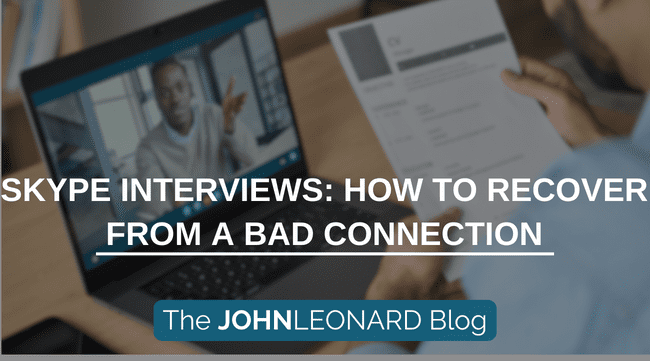Today, Skype interviews are increasingly common. They save you the hassle of taking time off to travel to another location, and they save your interviewer the money of having you visit. However, like many things in modern technology there can be a few technical glitches.
Despite vigilant efforts to avoid potential pit falls, you may face the sometimes unavoidable and always awkward bad connection. Dealing with this technical glitch is crucial to your interview performance.
You may have already done your homework, remembered to smile at the camera, not at the picture on the screen. You have set up your surroundings to look organized, changed your Skype name from “BlondieeeeX3” to something more professional. And you remembered to wear pants, just in case you do in fact need to stand up. But did you plan to expect a few glitches along the way?
Below are a few tips to help you recover from a bad connection.
Prevent
All wireless connections are not created equal. Try to avoid doing a Skype interview on an unfamiliar network such as the airport or your local coffee shop. These connections are often not equipped to handle a Skype call, and may cut out mid-interview. No one’s “freeze frame” face is flattering, and you want to do everything in your power to ensure you have a strong connection.
If possible, have a back up Ethernet cord. Though you may feel that this is extremely outdated, it still works. If possible, have a plan to hardwire into your internet if your connection is not ideal. Ethernet cords are often much more reliable than a wireless connection, and can be your saving grace if your Wi-Fi goes south.
“You want direct Ethernet access because it’s far more stable than wireless, and you want to have headphones in to avoid playback from the speakers.” says Fan Bi, Founder + Chief Shirt, Blank Label, Boston, Massachusetts.
Ensure your connection is viable before your interview. Skype with a friend first. Also, make sure that your microphone and camera are working and that your lighting and background look nice to the person on the other end.
While most employers are understanding, technical problems can take time out of your interview and reflect poorly on your ability to plan ahead.
Acknowledge
If you are experiencing persistent technical difficulties, acknowledge them. Trying to ignore the problem will not eliminate the problem.
Not only does overlooking the problem put you at risk for mishearing a question, but it can also make you seem as though you are unreliable. Employers may view someone who looks the other way at a technical glitch as someone who ignores problems, or is not proactive.
Acknowledge that there may be some technical difficulties, and better yet, offer a potential solution.
Solve
If technical problems persist, and your “excuse me’s” seem to be overtaking the conversation, you want to try and solve the problem. Often times, stopping the call and redialing can eliminate several issues. You can also try to hardwire into your internet connection with an Ethernet.
Sometimes, however, these problems are not easily solved.
Laura Tucker suggests, “If the problem can’t be fixed, suggest rearranging the interview or, for audio problems, suggest using a phone to speak while still using the camera. Whatever the problem, don’t get angry, don’t start hitting your computer and definitely don’t start swearing at it – even if you think the interviewer can’t hear you!”
Offering solutions to the problem and taking on a can-do attitude demonstrate leadership and accountability.
You want to put your best (digital) face forward to your perspective employer. Being proactive about preventing, acknowledging, and solving the problem not only positions you as a convergent thinker, but it also ensures that you will give your best interview possible.
Want more information that will help you to succeed in your career? Subscribe to our JOHNLEONARD blog below and receive the latest career advice!

